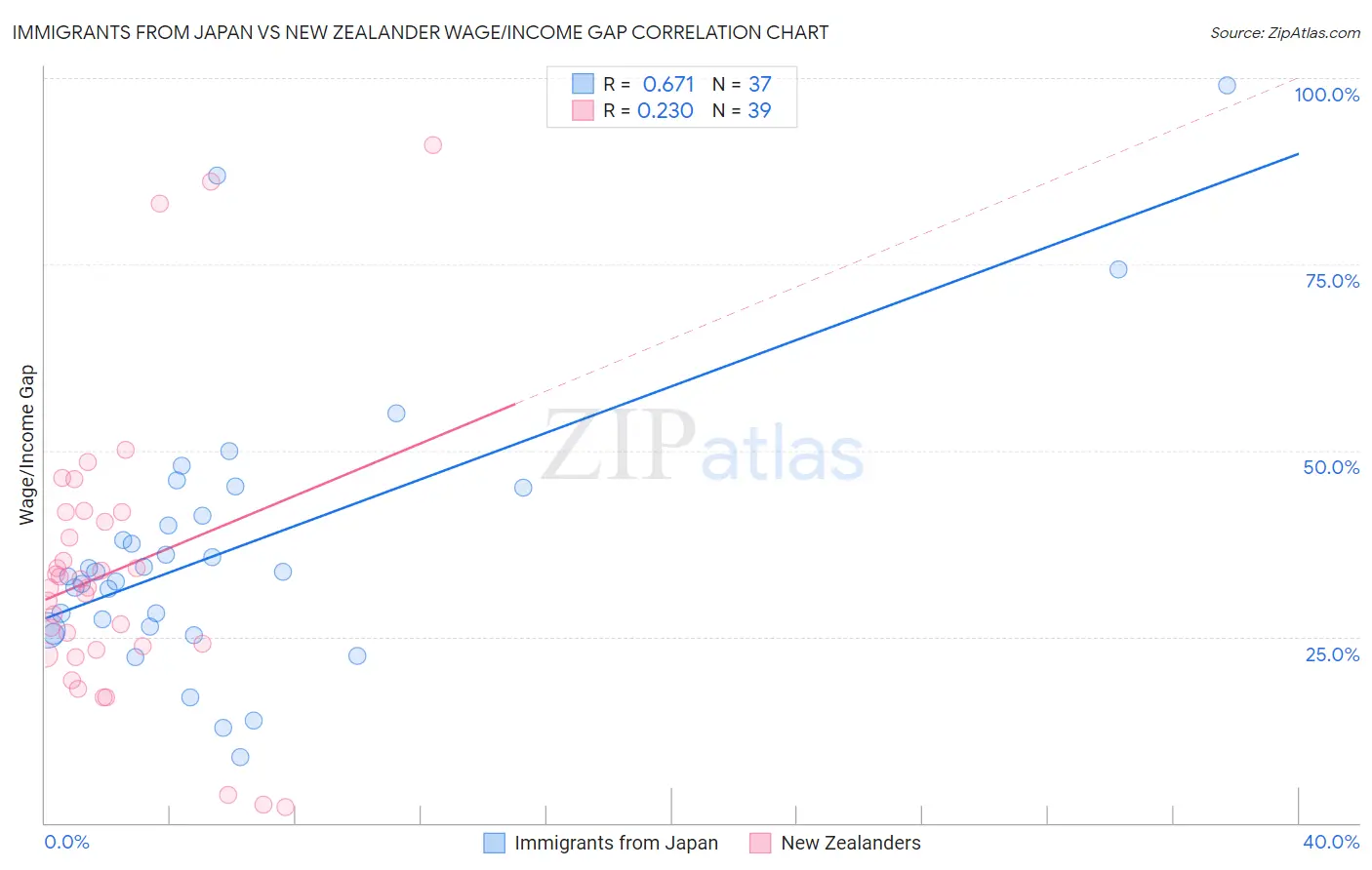Immigrants from Japan vs New Zealander Wage/Income Gap
COMPARE
Immigrants from Japan
New Zealander
Wage/Income Gap
Wage/Income Gap Comparison
Immigrants from Japan
New Zealanders
27.9%
WAGE/INCOME GAP
0.7/ 100
METRIC RATING
275th/ 347
METRIC RANK
27.7%
WAGE/INCOME GAP
1.0/ 100
METRIC RATING
268th/ 347
METRIC RANK
Immigrants from Japan vs New Zealander Wage/Income Gap Correlation Chart
The statistical analysis conducted on geographies consisting of 339,998,398 people shows a significant positive correlation between the proportion of Immigrants from Japan and wage/income gap percentage in the United States with a correlation coefficient (R) of 0.671 and weighted average of 27.9%. Similarly, the statistical analysis conducted on geographies consisting of 106,903,944 people shows a weak positive correlation between the proportion of New Zealanders and wage/income gap percentage in the United States with a correlation coefficient (R) of 0.230 and weighted average of 27.7%, a difference of 0.51%.

Wage/Income Gap Correlation Summary
| Measurement | Immigrants from Japan | New Zealander |
| Minimum | 8.9% | 2.1% |
| Maximum | 99.0% | 91.0% |
| Range | 90.1% | 88.9% |
| Mean | 36.7% | 33.8% |
| Median | 33.6% | 31.6% |
| Interquartile 25% (IQ1) | 26.1% | 23.2% |
| Interquartile 75% (IQ3) | 43.1% | 41.8% |
| Interquartile Range (IQR) | 17.0% | 18.5% |
| Standard Deviation (Sample) | 18.4% | 19.3% |
| Standard Deviation (Population) | 18.2% | 19.1% |
Demographics Similar to Immigrants from Japan and New Zealanders by Wage/Income Gap
In terms of wage/income gap, the demographic groups most similar to Immigrants from Japan are Lebanese (27.9%, a difference of 0.030%), Latvian (27.9%, a difference of 0.030%), American (27.8%, a difference of 0.080%), Immigrants from England (27.9%, a difference of 0.11%), and Bulgarian (27.8%, a difference of 0.12%). Similarly, the demographic groups most similar to New Zealanders are Potawatomi (27.7%, a difference of 0.010%), Turkish (27.7%, a difference of 0.080%), Immigrants from Switzerland (27.7%, a difference of 0.10%), Serbian (27.7%, a difference of 0.10%), and Hmong (27.7%, a difference of 0.10%).
| Demographics | Rating | Rank | Wage/Income Gap |
| Immigrants | Germany | 1.5 /100 | #261 | Tragic 27.5% |
| Immigrants | Lebanon | 1.5 /100 | #262 | Tragic 27.5% |
| Syrians | 1.4 /100 | #263 | Tragic 27.6% |
| Immigrants | Switzerland | 1.0 /100 | #264 | Tragic 27.7% |
| Serbians | 1.0 /100 | #265 | Tragic 27.7% |
| Hmong | 1.0 /100 | #266 | Tragic 27.7% |
| Turks | 1.0 /100 | #267 | Tragic 27.7% |
| New Zealanders | 1.0 /100 | #268 | Tragic 27.7% |
| Potawatomi | 0.9 /100 | #269 | Tragic 27.7% |
| Immigrants | Western Europe | 0.9 /100 | #270 | Tragic 27.8% |
| Ute | 0.8 /100 | #271 | Tragic 27.8% |
| Immigrants | Korea | 0.8 /100 | #272 | Tragic 27.8% |
| Bulgarians | 0.7 /100 | #273 | Tragic 27.8% |
| Americans | 0.7 /100 | #274 | Tragic 27.8% |
| Immigrants | Japan | 0.7 /100 | #275 | Tragic 27.9% |
| Lebanese | 0.7 /100 | #276 | Tragic 27.9% |
| Latvians | 0.7 /100 | #277 | Tragic 27.9% |
| Immigrants | England | 0.6 /100 | #278 | Tragic 27.9% |
| Romanians | 0.5 /100 | #279 | Tragic 28.0% |
| Russians | 0.5 /100 | #280 | Tragic 28.0% |
| Burmese | 0.5 /100 | #281 | Tragic 28.0% |